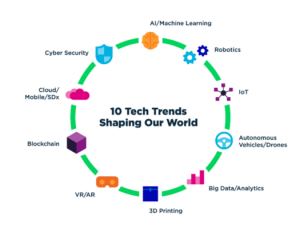10大技術トレンド:なぜオープンソースが主役なのか – パート2
フリーソフトウェアとオープンソースソフトウェアには、長年にわたる興味深い歴史があります。その起源は、Richard Stallman(リチャード・ストールマン)氏のプリンタに関する厄介な問題や、Linus Torvald(リーナス・トーバルズ)氏のヘルシンキ大学在学中のコンピューターサイエンスプロジェクトまで遡ることができます。
それ以来、様々な変遷を辿ってきました。
 オープンソースソフトウェアは、もはや単なる学生プロジェクトではなく、ましてや愛好家やハッカーだけの領域でもありません。現在では、コンピューティング市場のあらゆる分野を実質的に支配しており、個々の消費者から最大手のグローバル企業に至るまで、あらゆる人が使えるITとして、信頼性の高い不動の地位を獲得しています。
オープンソースソフトウェアは、もはや単なる学生プロジェクトではなく、ましてや愛好家やハッカーだけの領域でもありません。現在では、コンピューティング市場のあらゆる分野を実質的に支配しており、個々の消費者から最大手のグローバル企業に至るまで、あらゆる人が使えるITとして、信頼性の高い不動の地位を獲得しています。
現在、オープンソースプロジェクトは、世界に影響を及ぼす戦略的な技術トレンドの最前線にあります。まだその採用を決断していない企業でも、これらのトレンドをしっかりと見極め、活用すべき時期が来るまでに準備万端整えるようにしましょう。
この2部構成のブログシリーズのパート1で最初の5つの技術トレンドを取り上げました。以下に、残る5つのトレンドを紹介しましょう。
6.3Dプリンタ
3Dプリンタは、すでに航空宇宙、製造、 F1レーシングカー、ドローン、義足、医学研究、さらには大規模な産業建設プロジェクト用の特殊部品の設計と製造に使用されています。
一部の予想によると、3Dプリンタの市場価値は、2023年までに320億ドルを超えると言われています。
調査会社のガートナーは、3Dプリンタに関して2021年までに次のことを予想しています:
- 新型の商用および軍用航空機の75%が、3Dプリンタで製造したエンジン、機体およびその他の部品を使用する
- 外科医の25%が、3Dプリンタで作成した患者のモデルで、手術前にシミュレーションをする
- 世界のトップ100の消費財企業の20%が、3Dプリンタを使用してカスタム製品を作成する
3Dプリンタ業界とオープンソースコミュニティはうまく連携が取れています。オープンなハードウェア設計とオープンソフトウェアのソースコードの両方が利用可能な3Dプリンタが数多くあります。こういったオプションに興味がお有りでしたら、このall3dp.comリストをチェックしてください。
RepRapから自己複製オープンソース3Dプリンタを入手することもできます。このプリンタを使って、友達用のプリンタを作成するのに必要なすべてのパーツを印刷することができます。また、自由にダウンロードして利用できるオープンソースの3D画像ファイル(あらかじめ設計された製品テンプレート)が大量に提供されています。
7.VR/AR
バーチャルリアリティ(VR)と拡張現実(AR)は、これまでのコンピュータゲームやフライトシミュレータの市場の境界を越えて爆発的に成長する寸前にあります。
VRとは、現実感を伴う疑似体験やインタラクションが可能なコンピュータで生成されたデジタル環境を意味しています。ARはVRエレメントやリアルタイム情報を実世界の視点に重ね合わせて、すでに経験していることを拡張させます。ポケモンGOを思い出せば理解しやすいでしょう。
IDCは、AR/VR製品およびサービスへの支出が2018年に270億ドルに達すると予測しています。1年前のほぼ倍の金額です。ガートナーは、2020年までにAR、VR、および複合現実の没入型ソリューションが、デジタルトランスフォーメーション戦略の一環として、大企業の20%によって評価され、採用されると予測しています。
VRとARは、トレーニング(航空パイロットや外科医など)、医療(理学・心理療法)、観光とテーマパーク、製品と建築の視覚化、芸術、スポーツ、エンターテインメントなどに活用されることが期待されています。
VRとARの分野は、オープンソースの可能性に満ちています。ここで2つの例を見てみましょう。
- VRを駆使したアプリケーション、ゲーム、デジタルツイン、没入型メディアの作成には、さまざまなオープンソースプラットフォームとエンジンが利用できます。例として、ApertusVR、OpenSpace3D、OSVRをご覧ください。
- スマートフォンがその周辺を感知し、起きている事象を理解し、得られた情報とユーザがインタラクションできるようにするARアプリケーションが有ります。これを構築するために、オープンソースのSDK(ソフトウェア開発キット)を利用することができます。GoogleのARCore、DroidAR、またはARToolKitをチェックしてください。
8.ブロックチェーン
ブロックチェーンはビットコイン仮想通貨とほとんど不可分の関係にあり、最近は両者とも大変活発な広報活動が行われています。仮想通貨の考え方全体には懐疑的な人でも、ブロックチェーンについては知りたいと思うことでしょう。
ブロックチェーンを使用すると、デジタル分散型元帳を設定することができます。それは、事実上、データと取引の変更不可で透過的な記録です。世界的規模の真実の記録と考えてください。政府、金融、商業、および医療の分野で興奮の渦を巻き起こしているのも不思議ではありません。
451 Researchによると、28%の企業がすでにブロックチェーンを検証していると報告されています。
企業にとって、次の要素のいずれかが重要であるならば、検証作業を実施すべきです。
スマートコントラクト、ユーザ認証不正アクセス管理、反マネーロンダリング、合法的取引および金融取引、安全でアクセス可能な個人記録、IoTシステムのセキュリティ確保。
ご想像のとおり、オープンソースは、最高のブロックチェーン技術オプションとプラットフォームを提供しています。それらには、HyperLedger、Openchain、Ethereum、HydraChain(Ethereumプラットフォームの拡張版)、Quorum、MultiChainが含まれます。
情報が偏らないように、ブロックチェーンには非常に特殊な用途があることを指摘しておきます。それは全ての人にとって興味深いものとはいえません。ブロックチェーンがあなたのビジネスに適しているかどうかを判断するために、この世界経済フォーラムの記事の11の質問をご覧ください。
9.クラウド/モバイル/SDx
クラウドコンピューティングが世に現れてから20年以上も経ちました。これが十分に確立された技術だとすれば、未だに「ホットな技術トレンド」だと言えるのでしょうか?はい、言えると思います。
クラウドコンピューティングとモバイルITソリューションへの投資は、衰えることは有りません。クラウドITは、私がこれまで取り上げた技術トレンドにおける大部分の技術と連携する共通の要素です。ソフトウェア定義型技術(SDx)への移行は止まらず、スマートフォンは、私たちを取り囲む情報とメディア主導の世界へのポータルになっています。
オープンソースがクラウドコンピューティングの主役であることは驚くことではありません。ここで有名なジョークを思い出しました。
子供:パパ、雲は何からできているの?
父:ほとんどLinuxサーバだよ。
マイクロソフトによると、AzureのVM(仮想マシン)の40%がLinux上で稼働しています。ほとんどの評論家は、実際の割合はそれよりはるかに高いと考えています。
OpenStackは、オープンソースのクラウドプラットフォームを求めている人にとっては間違いなく最善の選択肢です。Cephは、クラウドストレージの経済性を変革する理想的なソフトウェア定義型ストレージ(SDS)ソリューションです。また、KubernetesとCloud Foundryは、瞬く間に、コンテナ化されたアプリケーションやクラウドネイティブアプリケーションにとって欠かせないオープンソースになりました。
10.サイバーセキュリティ
データセキュリティ侵害、ウィルス、ランサムウェア攻撃、その他の脅威は毎日ニュースを賑わしています。
サイバーセキュリティは、ほぼすべてのITリーダーにとって最大の懸念事項になっています。それはなぜでしょうか?企業が事業目標を達成し評判を守る能力に影響するためです。もちろん、従業員の業務やキャリアにも影響します。
ガートナーが、今年のセキュリティ支出額は世界全体で960億ドルに達すると予測しているのも不思議ではありません。
脅威はあらゆる方向から襲来し、オープンソースソフトウェアも免れることはできません。しかし、オープンソースソフトウェアにはいくつかの大きなメリットがあります。まず、背後にコミュニティの力があります。コードはオープンです。したがって、誰もが見ることができます。バグや問題を迅速に特定し修正することができます。その最たる例として、SUSEとLinuxコミュニティが、MeltdownとSpectreのプロセッサ/チップセットの脆弱性に対応し、極めて迅速にパッチがリリースされたケースが挙げられます。
数多くのオープンソースのセキュリティツールも利用できます。このHackerTarget.comウェブページにアクセスして、15の重要なオープンソースセキュリティツールのリストをご覧ください。
オープンソースの明るい未来
オープンソースソフトウェアが広く普及していくことは間違いないようです。過去30年にわたるテクノロジーの歴史の中で、その地位を獲得するために戦ってきました。それに加えて、コミュニティによって生み出された高度な技術革新により、オープンソースが将来の技術トレンドの鍵を握る要素となることは明らかです。
SUSEは当初からこの技術に携わってきたことを誇りに思います。オープンソースは当社の存在理由です。
オープンソースのジャーニーに少しでも支援が必要でしたら、SUSEがガイダンスを提供します。Linuxからソフトウェア定義型インフラストラクチャおよびアプリケーションデリバリープラットフォームまで、エンタープライズレベルのオープンソースソリューションを導入する支援をいたします。
このブログは10 Top Tech Trends – Why Open Source is Center Stage – Part 2の翻訳です。
Related Articles
6月 29th, 2023
No comments yet